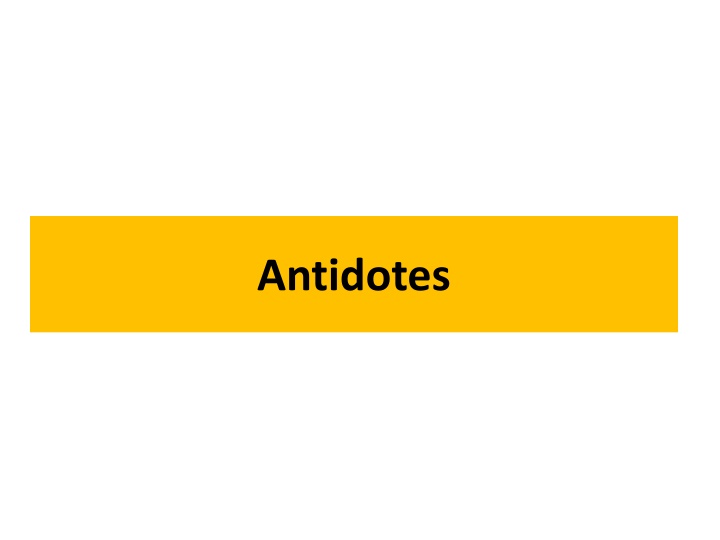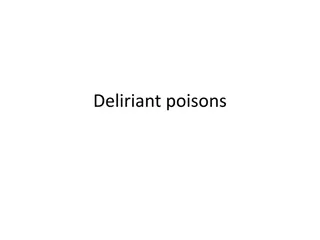
Antidotes for Poisoning: Types and Mechanisms
Explore the world of antidotes - substances that reverse, counteract, and stop the effects of poison. Learn about the classification of antidotes based on their mechanisms, such as physiological, chemical, and mechanical antidotes. Discover the role of antidotes in cyanide poisoning, including the use of sodium nitrite and sodium thiosulphate to counteract the toxic effects. Uncover how these antidotes work at a physiological level to protect vital enzymes and facilitate toxin elimination.
Download Presentation

Please find below an Image/Link to download the presentation.
The content on the website is provided AS IS for your information and personal use only. It may not be sold, licensed, or shared on other websites without obtaining consent from the author. If you encounter any issues during the download, it is possible that the publisher has removed the file from their server.
You are allowed to download the files provided on this website for personal or commercial use, subject to the condition that they are used lawfully. All files are the property of their respective owners.
The content on the website is provided AS IS for your information and personal use only. It may not be sold, licensed, or shared on other websites without obtaining consent from the author.
E N D
Presentation Transcript
What are antidotes? Antidote: Antidote is any substance which reverse, counteracts, stop the effect of poison.
Classification Depending on their mechanism of antidote are classified into, 1. Physiological antidote: It counteracts effect of poison by producing other physiological effect Example- Sodium nitrite in cyanide poisoning.
2. Chemical antidote: It changes chemical nature of poison. Examples- Sodium Thiosulphate in cyanide poisoning Chelating agents- Sodium & Calcium Edetate
3. Mechanical antidote: They prevent absorption of poison across the intestinal wall by adsorbing the toxins on to their surface. E.g.Activated charcoal and kaolin.
Role of antidote in cyanide poisoning: In cyanide poisoning, sodium nitrite and sodium thiosulphate are used as antidotes. Firstly injection of sodium nitrite is given which causes the oxidation of the ferrous (Fe++) ion of (Fe+++) haemoglobin to the ferric ion of methaemoglobin.
The methaemoglobin then combines with serum cyanide that has not yet entered the cell to produce cyanomethaemoglobin, thus protecting the essential cytochrome oxidase enzyme from the cyanide ion.
This cytochrome oxidase enzyme is required for electron transfer cycle and cellular respiration. After 5 minutes a slow intravenous infusion of sodium thiosulphate is given. The thiosulphate ions react with cyanide ions in presence of rhodanese enzyme to non-toxic thiocynate ions which is excreted through the urine
List of antidote along with the types of poisoning treated Sodium nitrite cyanide poisoning Sodium thiosulphate- cyanide poisoning Desferrioxamine- Iron salt BAL/Dimercaprol- mercury salt Penicillamine- Copper and lead salt Calcium chloride- fluoride Hydrogen peroxide-Phosphorous
References Pharmaceutical inorganic chemistry volume I, by G. R. Chatwal published by himalaya page no 365 https://www.google.co.in/image





